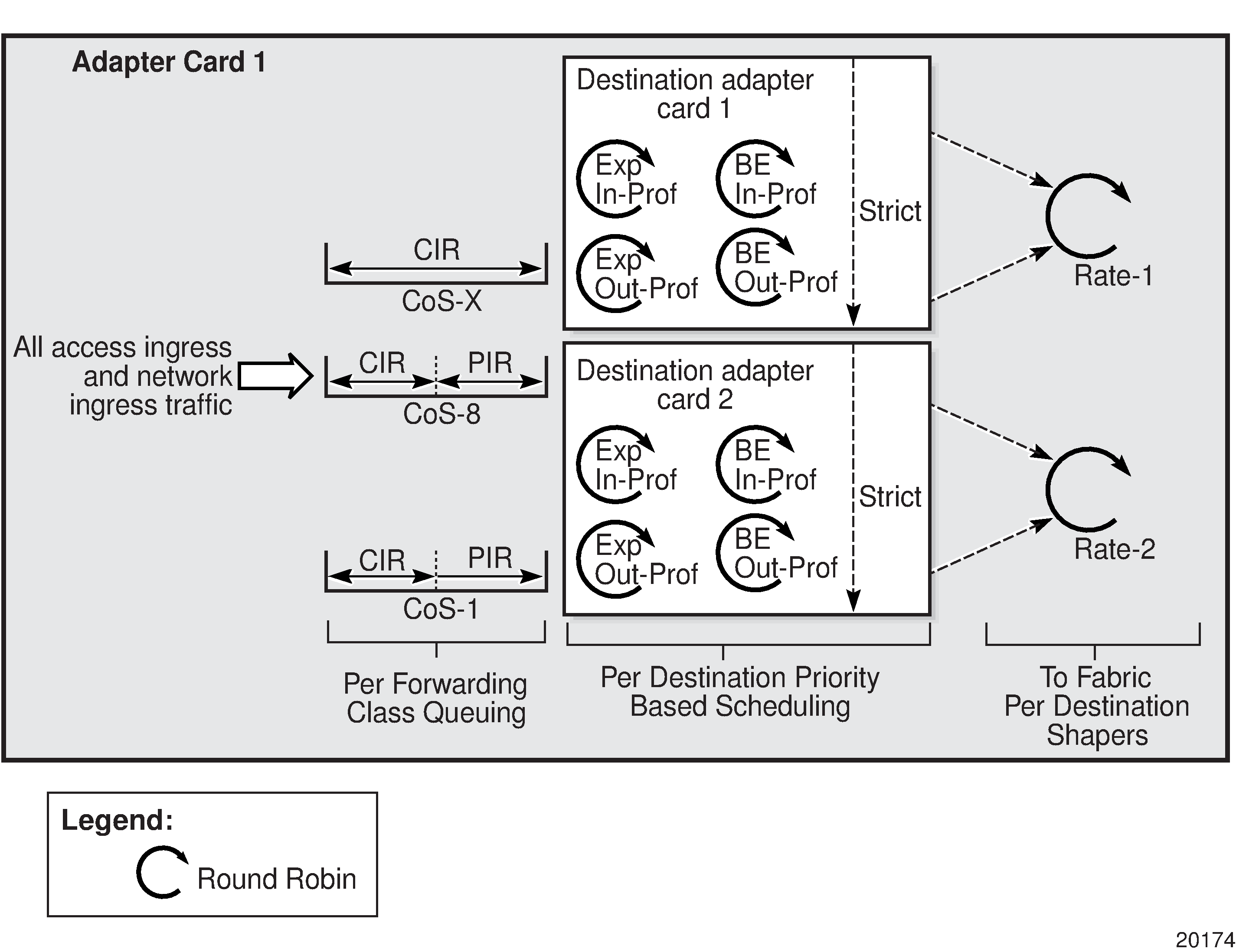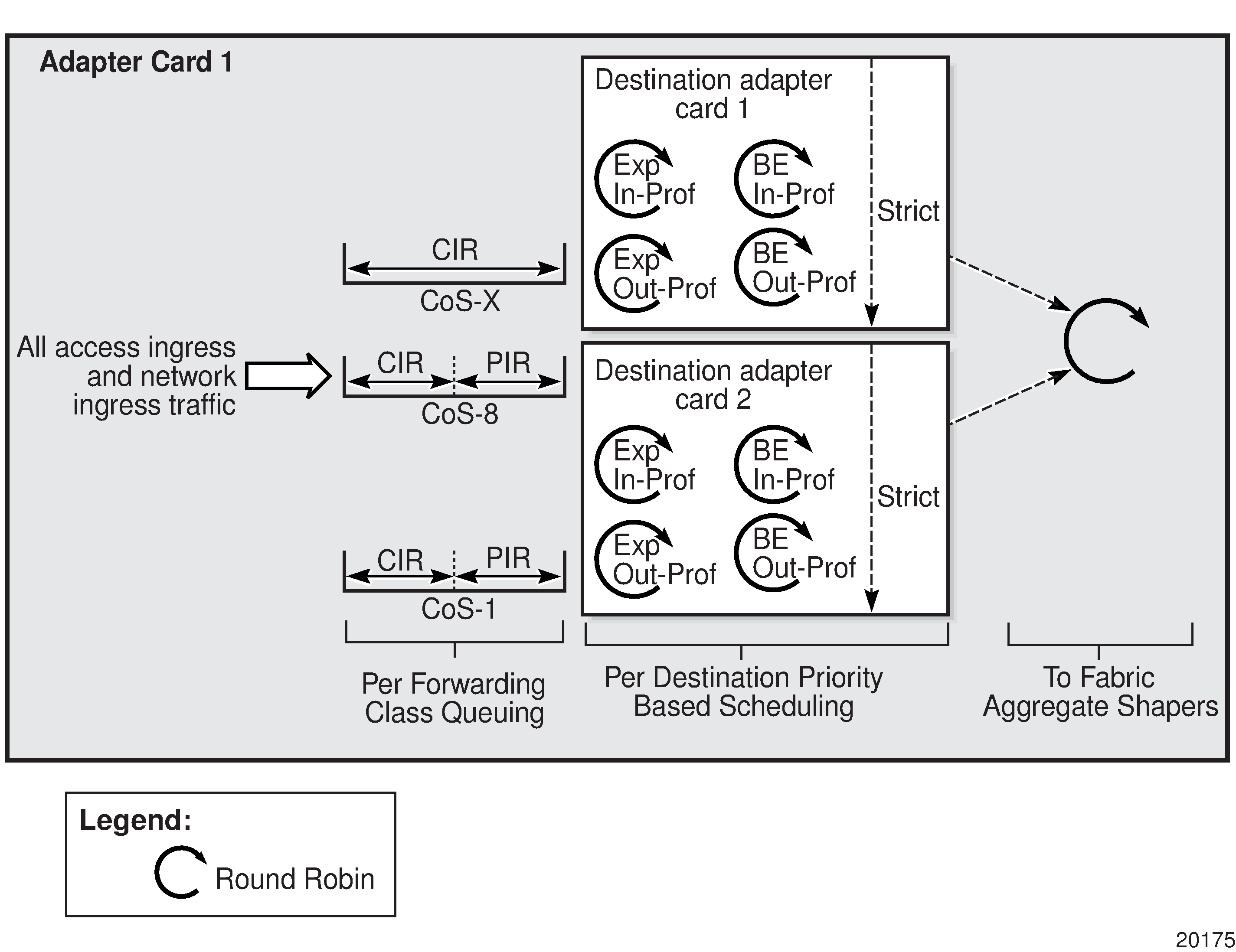The use of fabric profiles allows the ingress (to the fabric) shapers to be user-configurable for access ingress and network ingress traffic.
For the 7705 SAR-8 Shelf V2 and 7705 SAR-18, the maximum rates are:
2.5 Gb/s for the 7705 SAR-8 Shelf V2 (all 6 MDA slots)
-
10 Gb/s for the 7705 SAR-8 Shelf V2 (MDA slots 1 and 2)
1 Gb/s or 2.5 Gb/s for the 7705 SAR-18 (12 MDA slots)
10 Gb/s for the 7705 SAR-18 (4 XMDA slots)
For information about fabric shapers on the 7705 SAR-M, 7705 SAR-H, 7705 SAR-Hc, 7705 SAR-A, 7705 SAR-Ax, and 7705 SAR-X, see Fabric Shaping on the Fixed Platforms (Access and Network).
By allowing a rate of 1 Gb/s or higher to be configured from any adapter card to the fabric, the fabric may become congested. Therefore, the collection and display of fabric statistics are provided. These statistics report about the fabric traffic flow and potential discards. See the 7705 SAR Interface Configuration Guide, ‟Configuring Adapter Card Fabric Statistics”, ‟Configuration Command Reference”, and ‟Show, Monitor, Clear, and Debug Command Reference” for information about how to configure, show, and monitor fabric statistics on an adapter card.
The ingress buffers for a card are much larger than the ingress buffers for the fabric; therefore, it is advantageous to use the larger card buffers for ingress shaping. In order to use the ingress card buffers and have much more granular control over traffic, two fabric profile modes are supported, per-destination mode and aggregate mode. Both modes offer shaping towards the fabric from an adapter card, but per-destination shapers offer the maximum flexibility by precisely controlling the amount of traffic to each destination card at a user-defined rate. Aggregate mode is used for simpler deployments, where the amount of traffic flowing to a destination adapter card is not controlled.
The default mode of operation for the 7705 SAR is set to aggregate, and the fixed aggregate rate of 200 Mb/s is set for both access ingress and network ingress traffic. Therefore, in a default configuration, each adapter card can switch up to 200 Mb/s of access ingress and network ingress traffic towards the fabric.
All the switched traffic can be destined for a single adapter card or it can be spread among multiple adapter cards. For higher-bandwidth applications, a network traffic analysis is recommended to determine which shaper rates would best suit the application and traffic patterns of a particular environment.
The to-fabric shapers are provided on the 7705 SAR to ensure adequate use of ingress buffers in case of congestion. With the ingress shapers, the large ingress card buffers can be configured to absorb bursty traffic and pace the traffic for better use of resources.
For example, if the average access ingress traffic bandwidth for an adapter card is 400 Mb/s and the peak bandwidth is 800 Mb/s, the rate of the to-fabric shapers can be configured to be 400 Mb/s. This allows the bursty ingress traffic to be paced by absorbing the bursty traffic after being shaped at 400 Mb/s. The initial burst is absorbed at the adapter card where the bursty traffic ingresses the 7705 SAR. The ingress buffers are used to absorb the burst and the fabric buffers are not exhausted by any single adapter card. The same example applies to network ingress traffic.
Table: Fabric Profile Modes Options and Capabilities summarizes the different capabilities offered by the two modes.
Capability |
Per Destination Mode |
Aggregate Mode |
|---|---|---|
Access ingress to-fabric shapers |
✓ |
✓ |
Network ingress to-fabric shapers |
✓ |
✓ |
Individual shaping from an ingress card towards each destination card based on a user-defined rate |
✓ |
|
Aggregate/bulk sum shaping regardless of destination from an ingress card |
✓ |
Figure: Fabric Shapers in Per Destination Mode and Figure: Fabric Shapers in Aggregate Mode illustrate the functionality of fabric shapers in per-destination mode and aggregate mode, respectively.
Referring to Figure: Fabric Shapers in Per Destination Mode, once the per-destination prioritization and scheduling takes place, as described in previous sections in this chapter, the per-destination adapter card shapers take effect. With per destination shapers, the maximum amount of bandwidth that each destination adapter card can receive from the fabric can be controlled. For example, the maximum amount of bandwidth that adapter card 1 can switch to the remaining adapter cards, as well as the amount of bandwidth switched back to adapter card 1, can be configured at a set rate.

Figure: Fabric Shapers in Aggregate Mode illustrates the functionality of fabric shapers in aggregate mode. Once the policing, classification, queuing and per-destination based priority queuing takes place, as described in previous sections in this chapter, the aggregate mode adapter card shapers take effect. In aggregate mode, the aggregate of all the access ingress and network ingress traffic is shaped at a user-configured rate regardless of the destination adapter card.

Mixing different fabric shaper modes within the same chassis and on the same adapter card is not recommended; however, it is supported. As an example, an 8-port Gigabit Ethernet Adapter card in a 7705 SAR-18 can be configured for aggregate mode for access ingress and for per-destination mode for network ingress. The same chassis can also contain an adapter card (for example, the 32-port T1/E1 ASAP Adapter card) that is configured for per-destination mode for all traffic. This setup is shown in the following example.
MDA |
Access Fabric Mode |
Network Profile Mode |
|
1/1 |
a8-1gb-v3-sfp |
Destination |
Destination |
1/2 |
a8-1gb-sfp |
Aggregate |
Destination |
1/3 |
a4-oc3 |
Destination |
Destination |
1/4 |
a32-chds1v2 |
Destination |
Destination |
1/X1 |
x-10GigE-v2 |
Aggregate |
Destination |
Gen-2 and Gen-3 adapter cards only support aggregate mode fabric shapers for access ingress traffic, regardless of the service types configured.
If multipoint services such as IES, VPRN, and VPLS are running on an adapter card, only aggregate mode fabric profile can be configured for the card at access ingress.